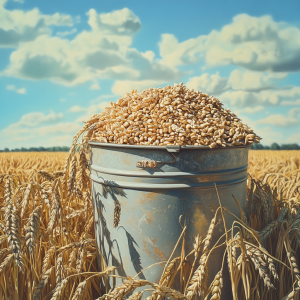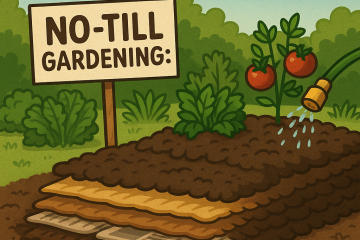
Neanderthals in the Kitchen by Kellene Vaile
Welcome back to my preparedness blog, fellow Neanderthals in the Kitchen! Today, we’re diving into the hotly debated topic of whether or not to use oxygen absorbers (OAs) when storing your whole grain wheat. Now, if you’ve read my book, “Neanderthals in the Kitchen,” you already know where I stand: OAs are a no-go if you want to keep your wheat sproutable. Here’s a study. And another. And let’s face it, if you’re planning for long-term food security, sprouting your grains is one of the easiest ways to have fresh veggies long after the grocery shelves are empty.
But wait! There are some folks out there — possibly with degrees and lab coats — claiming that using OAs might actually help your grains sprout better. I actually found lots of studies that said the complete opposite of what I’m stating. So, what’s a prepared Neanderthal to do? Let’s break this down with a pinch of humor and a sprinkle of solid reasoning!
The Case Against Oxygen Absorbers for Sprouting
First, let’s get one thing straight: whole grains are alive! Well, at least they are until you suffocate them. Grains, like seeds, need oxygen to stay viable for sprouting. It’s like trying to breathe with a plastic bag over your head — not ideal. When you use an oxygen absorber, you’re creating an anaerobic (oxygen-free) environment. Sure, this is great for keeping out the creepy crawlies (who are rude enough to snack on your stash without asking), but it’s also not so great if you want to keep your grains alive and kicking for sprouting purposes.
In my book, I suggest avoiding OAs for exactly this reason. Instead, use food-grade diatomaceous earth to handle the bugs. DE is like kryptonite to creepy crawlies — it slices, it dices, and it keeps your grains safe without cutting off their air supply. Your grains can still breathe (metaphorically, of course) and will sprout like champions when you’re ready to turn them into tasty sprouts or wheatgrass.
The Opposing View: Oxygen Absorbers Make Grains Sprout Better?

Sprouting wheat does NOT benefit from oxygen absorbers
Now, I know some of you might be thinking, “But, there are studies!” Yes, there are always studies. Some of these studies suggest that grains stored with oxygen absorbers may actually have a higher sprouting rate. And to that, I say: it’s all in the details! Many of these studies don’t tell you the whole story — like the fact that they might be looking at a very controlled environment where every other factor (humidity, temperature, moisture content) is optimized.
In the real world of grain storage, where you don’t have a scientist on staff to manage your wheat pantry, things get a bit messier. Even minor moisture can cause a lot of trouble when combined with an oxygen-free environment. Mold, anyone? Additionally, if you’re storing for the long haul, do you really want to risk the ability of your grain to sprout just because of a few “scientific” claims? I don’t think so!
The Sprouting Solution: Keep It Simple, Keep It Breathable!
Here’s the thing: If you’re prepping for the long term, you want flexibility. You want to be able to sprout your grains not just for the nutritional benefits but also to add a little variety to your apocalypse diet. I mean, even the most die-hard prepper will eventually get tired of porridge! Sprouting your grains allows you to turn those boring kernels into something crunchy, green, and full of life.
Instead of gambling on whether OAs will kill or enhance your sprouting game, play it safe. Use DE to keep the pests away, store your grains in a cool, dry place, and let them have the oxygen they need to remain viable. You’ll thank me when you’re harvesting your little sprouts in your kitchen, adding some freshness to your stored food diet.

Weevils are inherent in whole grains
But What About the Bugs?!
I hear you — bugs are gross. But trust me, you don’t need oxygen absorbers to keep them out. Food-grade diatomaceous earth is your new best friend. It’s natural, it’s safe, and most importantly, it won’t murder your grains’ sprouting dreams. Sprinkle it into your storage bins, and it will act like a microscopic ninja, slicing and dicing any pests that dare to invade. Plus, DE has no effect on your grains’ ability to sprout, so it’s a win-win!
Can I Use Food-Grade DE in Rice and Other Grains?
Yes, you can use food-grade DE in rice and other grains. However, I don’t recommend using it in flour. Use OAs to extend the life of flour instead. And remember that plastic is NOT impervious to oxygen and moisture.
Trust the Neanderthal in You
Bottom line on this, when in doubt, don’t. If you have such a great alternative solution to manage the creepy crawlies in food grade diatomaceous earth, why take the chance that you won’t be able to sprout later?
So, to sum it up: When it comes to whole grain wheat storage, skip the oxygen absorbers if you want sprouting flexibility. Use food-grade diatomaceous earth instead, and keep your grains happy, breathable, and ready to sprout into delicious, crunchy veggies whenever you need them.
And remember, dear readers, you don’t need a lab coat to know that a grain in hand is worth more when it’s alive and sproutable!

Use Food Grade diatomaceous earth for storing whole grains long term
Stay prepared, stay sproutable, and stay Neanderthal!
References:
- Wageningen University & Research study on low oxygen storage and seed viability:
- Research on oxygen sensitivity and germination of seeds:


